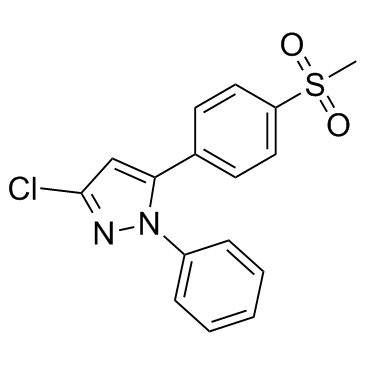| Description |
FR-188582 is a highly selective inhibitor of cyclooxygenase (COX)-2, with an IC50 value of 17 nM.
|
| Related Catalog |
|
| Target |
COX-2:17 nM (IC50)
|
| In Vitro |
In a recombinant human cyclooxygenase (COX) enzyme activity, FR-188582 (FR188582) inhibits COX-2 with an IC50 value of 17 nM, and the inhibition of prostaglandin (PG) E2 formation by FR188582 isover 6000 times more selective for COX-2 than COX-1[1].
|
| In Vivo |
Oral administration of FR-188582 (0.01-3.2 mg/kg) reverses paw edema in adjuvant arthritic rats and shows a therapeutic effect in a dose-dependent manner with ED50 values (95% C.L.) of 0.074 (0.00021-0.53) and 0.063 (0.0039-0.31) mg/kg for adjuvant-injected paws and adjuvant-uninjected paws, respectively. The anti-inflammatory effect of FR-188582 (FR188582) is threefold more potent than that of Indomethacin with ED50 values (95% C.L.) of 0.24 (0.047-1.8) and 0.20 (0.021-0.79) mg/kg for adjuvant-injected paws and adjuvant-uninjected paws, respectively[1].
|
| Kinase Assay |
Human recombinant COX-1 and COX-2 are expressed in Chinese hamster ovary cells. The appropriate COX enzyme (1 μg for COX-1 and/or 3 μg for COX-2) is preincubated in 100 mM Tris-HCl buffer (pH 7.3) containing hematin (2 μM) and tryptophan (5 mM) with drugs (0.0001-100 μM) dissolved in 1% DMSO for 5 min at 37°C prior to the addition of Arachidonic acid (10 μM) for 5 min at 37°C. Reactions are terminated by the addition of 1N HCl, and PGE2 production is measured by radioimmunoassay[1].
|
| Animal Admin |
Rats[1] Female Lewis rats (140-180g) at the age of 8 weeks are used. Adjuvant arthritis is induced in female Lewis rats by intradermal injection into the plantar suface of the right hind paw of 0.5 mg of a suspension of heat-killed and dried Mycobacterium tuberculosis H37 RA in 0.05 mL of liquid Paraffin (day 0). The drugs, suspended and diluted on 0.5% methylcellulose, are given orally once a day therapeutically from day 15 to day 24 after adjuvant injection. Paw volume is measured before and 15,18,21,24 days after adjuvant injection with the Volume Meter TK-105, and edema is expressed as the increase in paw volume after adjuvant injection relative to the pre-injection value for each animal.The anti-inflammatory effect is expressed as the difference in paw edema compared with that of vehicle-treated adjuvant-control rats.
|
| References |
[1]. Ochi T, et al. The anti-inflammatory effect of FR188582, a highly selective inhibitor of cyclooxygenase-2, with an ulcerogenic sparing effect in rats. Jpn J Pharmacol. 2001 Feb;85(2):175-82.
|
